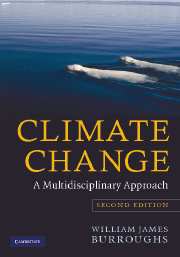Book contents
- Frontmatter
- Contents
- Preface to the second edition
- 1 Introduction
- 2 Radiation and the Earth's energy balance
- 3 The elements of the climate
- 4 The measurement of climate change
- 5 Statistics, significance and cycles
- 6 The natural causes of climate change
- 7 Human activities
- 8 Evidence of climate change
- 9 Consequences of climate change
- 10 Modelling the climate
- 11 Predicting climate change
- Glossary
- Bibliography
- Index
5 - Statistics, significance and cycles
Published online by Cambridge University Press: 05 June 2012
- Frontmatter
- Contents
- Preface to the second edition
- 1 Introduction
- 2 Radiation and the Earth's energy balance
- 3 The elements of the climate
- 4 The measurement of climate change
- 5 Statistics, significance and cycles
- 6 The natural causes of climate change
- 7 Human activities
- 8 Evidence of climate change
- 9 Consequences of climate change
- 10 Modelling the climate
- 11 Predicting climate change
- Glossary
- Bibliography
- Index
Summary
All is flux, nothing stays still.
Heraclitus, c540–c480 bcSqueezing useful information out of the available data is the essence of unravelling the causes of climate variability and climate change. The challenge is to exploit statistical techniques to tease out significant cycles, shifts or trends in the climate from the sea of noise that washes over all aspects of this subject. This requires a disciplined approach to avoid falling into the trap of attributing too much to what is nothing more than noise, because the one thing that is certain is that every aspect of the climate fluctuates on every timescale. So what really matters is to define specific meaning to the terms introduced in Chapter 1 (Figs 1.1 and 1.2) in order to substantiate any conclusions reached about past changes and to provide a benchmark for making predictions about the future.
This process of analysis is not just a matter of identifying significant changes in the climate (e.g. trends, cycles or sudden shifts) but also involves interpreting the properties of the associated variability. The latter can occur on every timescale within the period covered by the observations. The only way to conduct this analysis is to consider the statistical techniques designed to get the best out of noisy data. This involves a wide range of complicated mathematical techniques. These will not be discussed here. Instead we will concentrate on three practical matters. First, there is the problem of dealing with extreme events that are a normal part of climatic variability.
- Type
- Chapter
- Information
- Climate ChangeA Multidisciplinary Approach, pp. 121 - 150Publisher: Cambridge University PressPrint publication year: 2007



